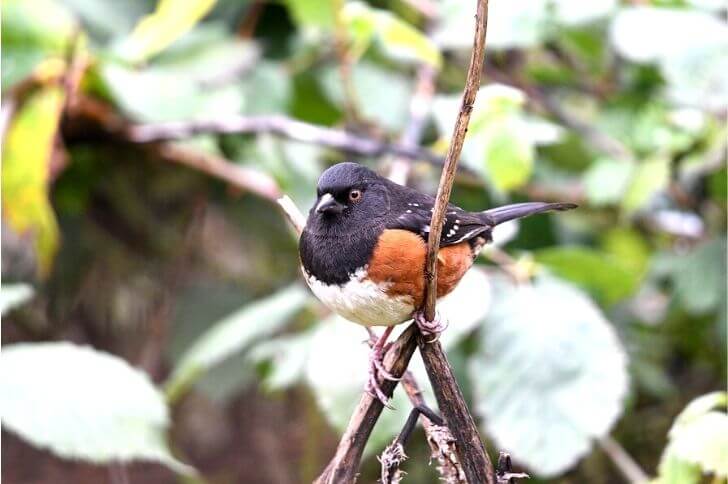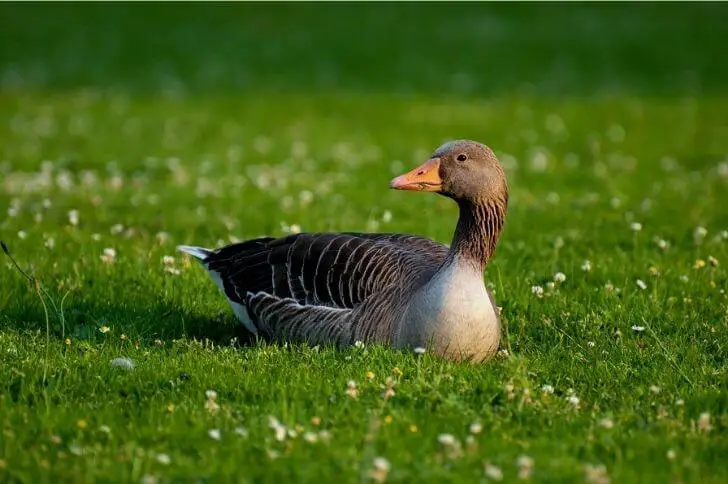A black bird with white belly is one of the most striking birds in the world. From the rocky mountains of North America to the Drakensberg in South Africa, there are numerous places where you can find white bellied birds.
How many black and white birds can you name? In the article below we’ll list over 21 birds that you can find in different habitats. Whether you are a new birder or a seasoned birdwatcher, you’ll find the list below useful.
List of Black Bird with White Belly
1. Black Phoebe

Size:
Perhaps the most well-known white bellied bird with black body, the black phoebe is a 6.3-inch bird; slightly large than dark eyed juncos. They weigh 0.5 – 0.8oz.
Plumage:
Very distinctive. Adult black phoebes are dark above and white below. Juveniles are browner above. Both sexes have a long tail and pinkish beak.
Habitat & facts:
Black Phoebes are small songbirds that range from California to Costa rica. They are most easily identified by their call, which is a loud, rapid series of chirps. During nesting season you’ll hear wheezy chatters.
They are usually found near water sources, such as rivers, streams, and lakes. They use these areas for foraging and nesting.These white bellied birds eat a variety of insects, including mosquitoes, mayflies, and dragonflies.
Nesting season for Black Phoebes begins in late February and lasts until July. These birds build their nests out of mud, sticks, grasses, and other materials they find near the water source.
2. Eastern Kingbird
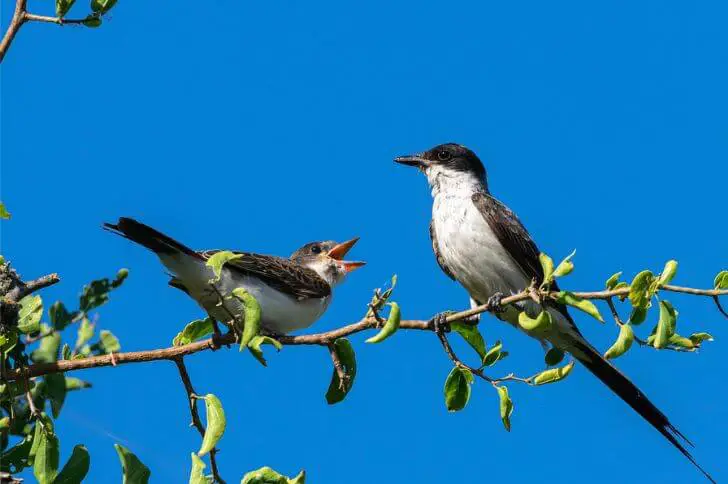
Size:
Medium-sized and social, Eastern kingbirds are about 7.5-9.1 inches (19-23 cm) with a 13-15 inches span. A mature bird can weigh up to 1.9 oz. These black birds with white bellies are almost the same size as jays.
Plumage:
Like the black phoebe, this bird has black upperparts and white below. Note the short black bill and dark colored eyes.
Habitat & facts:
The Eastern Kingbird is a migratory songbird that breeds in North America. It is the most common kingbird in the eastern United States.
It feeds mainly on insects, but also eats fruit. It forages by hovering or by perching on an open perch and catching insects in flight. This black bird with white belly is monogamous, and pairs for life. The nest is a small cup of twigs lined with grass or moss, which is usually built in a tree or shrub.
Females lay 3 – 5 eggs about 1-inch in length. Hatching happens after 14 – 17 days. You’ll notice the chicks are hatched naked with orange-colored skin.
3. White-bellied bush chat
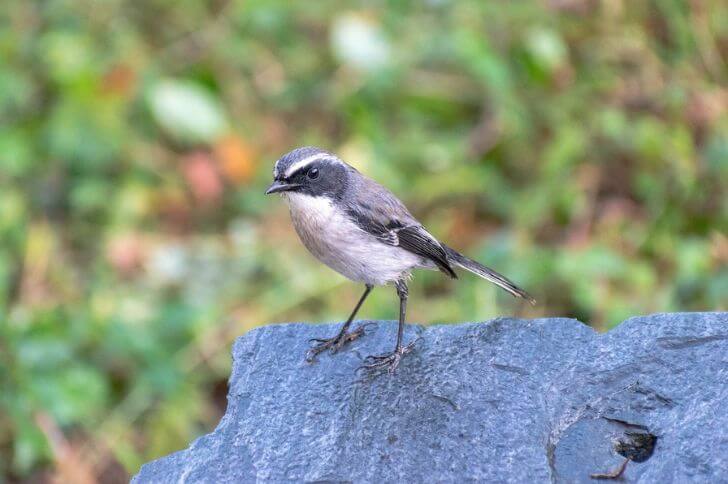
Size:
Measuring about 5.1 inches, the white-bellied bush chat is a Southeast Asian bird that is part of the old world flycatcher family. European robins and wheatears are part of this family.
Plumage:
Like other black and white birds, bush chats have dark backs, heads and are white below. Note the white patches on the wings and short bib. These birds would also fit perfectly on this list of birds with black beaks.
Habitat & facts:
These old world flycatcher birds prefer dry savanna and moist lowland forests. One of the things you’ll notice about these chats is the almost flat bills. These come in handy when hunting for insects in flight.
They are known for “tchuk” and “cherrgrrr-wichu” sounds.
4. Red-headed Woodpecker

Size:
How big is a red-headed woodpecker? These birds are mid-sized, about 7.5 – 9.5 inches from head to the tail feathers and a span of 16.7 inches. Adult woodpeckers can weigh from 2 to 3.4 oz.
Plumage:
Woodpeckers are some of the easiest birds to spot and this species is no different. Back is all black with white on wings, red head and whitish belly. They have a sturdy chisel-like bill. Young ones are duller with a brown head.
Habitat & facts:
The Red-headed Woodpecker is a passerine bird that is found in eastern North America. It typically inhabits wooded areas. It mostly feeds on insects, which it extracts from tree bark or other crevices using its stout bill.
Red-headed Woodpeckers are monogamous and territorial, and males perform elaborate courtship displays to attract mates. Breeding pairs excavate a nesting hole in a tree trunk, where they lay 3–10 eggs. The chicks are altricial and require extensive parental care.
Red-headed Woodpeckers have been listed as of Least Concern by the IUCN because they are common across their range and their population is thought to be stable.
5. Black-throated Gray Warbler
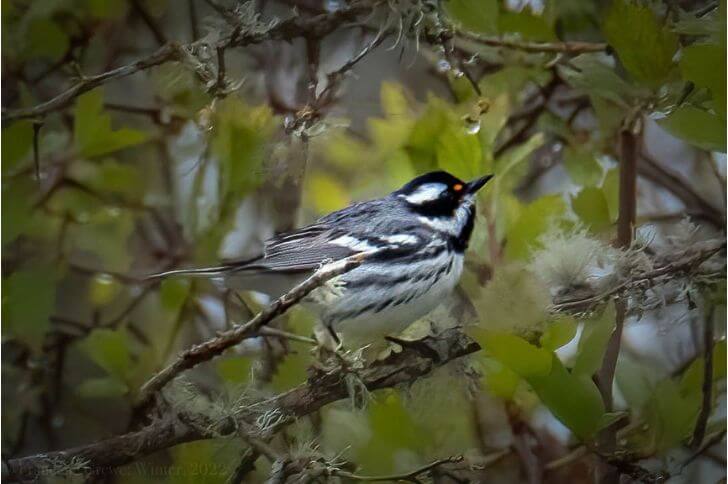
Size:
Ranging from California to British Columbia, the black-throated gray warbler is another unique white bellied bird. How big is a warbler? Black-throated gray warblers are about 5.1 inches long and weigh 0.3 oz. Their wings range 2.2 – 2.7 inches.
Plumage:
Unlike other black birds with white bellies on this list, these birds are not all black. Instead, be on the lookout for a small bird with white and black stripes. Its throat is all black and take note of the small yellow spot in front of the eyes. Both sexes are patterned.
Habitat & facts:
These warblers are small migratory songbirds endemic to parts of western North America. They breed in coniferous forests; females lay 3-5 o.8-inch long eggs. The whitish eggs are speckled and both parents care for the young warblers.
The Black-throated Gray Warbler is a very vocal bird, and its song is a series of clear high whistles, mostly “zeedle-zeet-chee” sounds. This warbler feeds mainly on insects, but will also eat seeds and berries. It forages by hopping along the ground or low in the trees, gleaning insects from leaves and branches.
This warbler is considered to be common throughout its range, and it is not considered to be at risk of extinction.
Related Read: Learn about various black birds
6. Tufted Titmouse
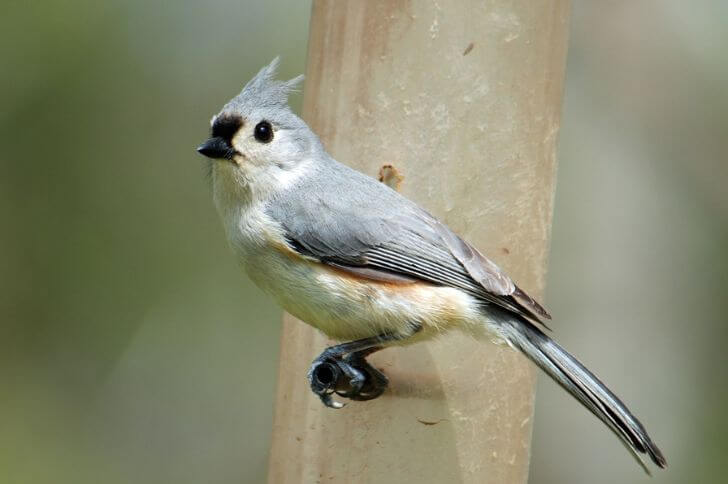
Size:
Tufted titmice are slightly larger than the warblers we’ve looked at above. On average, adults range 5.5 – 6.3, same size as house sparrows, with a wingspan of 7.9 -10.2 inches.
Plumage:
Though not totally black above, we’ve included them on this list because of the white bellies. Titmice have grayish upperparts and white underparts. Note the brownish sides.
Habitat & facts:
How do I attract titmice to my backyard? The simple of it, bird feeders. You’ll need to install a few in your yard and add sunflower seeds.
These birds are also known for their vocalizations, which include a variety of whistles and chatters. Tufted titmice form monogamous pairs and typically remain together year-round. During the winter, they will often roost together in large groups to keep warm.
7. White-bellied drongo

Size:
Ever heard of drongo birds? They are in the family dicruridae. An adult bird measures about 9.4 inches.
Plumage:
Apart from the white belly, you can easily identify them from their dull-black back and forked tail. Females have longer tails. Note their short black bill.
Habitat & facts:
Dicrurus caerulescens or white-bellied drogo are found throughout much of Southeast Asia. They are common residents of forest and woodland, and also often seen in open country near habitation.
They are very agile in the air, and catch insects by hovering over them before swooping down to snatch them up. These white bellied birds are usually solitary or found in pairs, but sometimes form small flocks. They are vocal birds, making a wide variety of calls including harsh cackles, whistles, and warbles.
8. White-bellied sea eagle
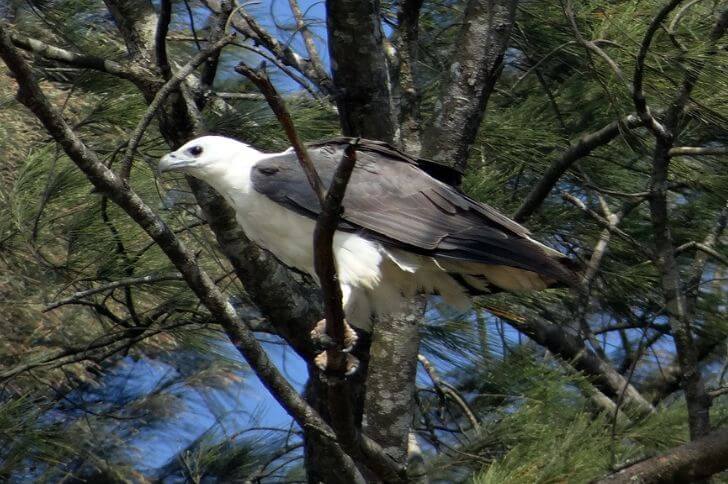
Size:
With white outer tail feathers, the white-bellied sea eagle is a large bird of prey that measures 26-31 inches for the males and 31-35 inches for the females. An adult can weigh 6.6 lbs with a wingspan of up to 7.2 feet.
Plumage:
Like the titmice, they are dark gray above and white below. Other distinctive features include black tail with white wing bars. Bill is curved and have sharp talons.
Habitat & facts:
The white-bellied sea eagle is one of the largest raptors in the world. They are found in coastal areas in parts of Southeast Asia. They are very opportunistic predators and will eat anything they can catch, including fish, birds, mammals, and reptiles.
They build large nests of sticks and branches in tall trees or on cliffs near the water’s edge. The female lays 2 eggs, which both parents incubate for about 45 days. The young eagles fledge at about 6 months old.
9. Blackpoll Warbler

Size:
Closely related to the black-throated gray warbler, the blackpoll warbler is a 4.9-5.9-inch bird with wings stretching to 7.9 to 9.8 inches. Like other birds in their family, they weigh around 0.5 oz.
Plumage:
With a black cap and thin bill, this large warble is unmistakable. Other distinctive features include white on cheeks and black-white stripes. Females are slightly different with duller bodies and heavy streaking.
Habitat & facts:
The Blackpoll Warbler is migratory, and winters in Central and South America. They are fairly common birds, but their migration is spectacular. Every fall, millions of Blackpoll Warblers take to the air and fly nonstop across the Atlantic Ocean to winter in South America. This journey is one of the longest known bird migrations.
10. White-breasted Nuthatch

Size:
Small and no neck, white-breasted nuthatch are small North American songbirds that measure up to 6.1 inches in length, same size as adult titmice.
Plumage:
Very distinctive. This species is mostly gray with black on the head and wing edges. Note the brownish patches on their underparts.
Habitat & facts:
These birds are common in forested areas, where they live mainly in trees, although they also forage on the ground. White-breasted nuthatches are insectivores, and they use their long, pointed bills to extract insects from crevices in bark and tree limbs. They are also known for their ability to hang upside down from branches while eating.
11. Black-billed Magpie
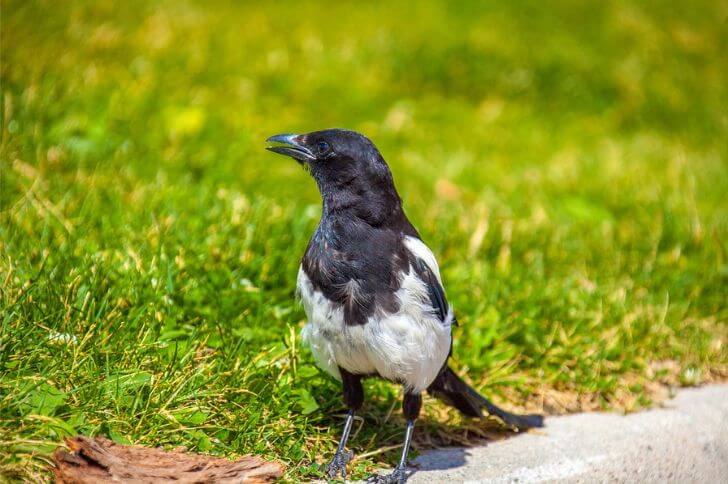
Size:
How big is a black-billed magpie? Also known as the American magpie, these birds are about 17.7-23.6 inches in length and boast of 22.1-24 inches. Adult birds weigh up to 7.6 oz.
Plumage:
Black back with blue on wings. White below with a ridiculously long tail. They have a dark thick bill.
Habitat & facts:
A member of the family Corvidae, this medium-sized bird is found in western North America. Populations are also found in east Asia, where it was introduced.
What does a black-billed magpie eat? They eat carrion, different types of insects, rodents, berries and more.
They live in pairs and their breeding season is typically from March to July. The typical clutch size is 6-7 eggs that take up to 21 days to hatch.
12. White-bellied thicket fantail
Size:
Beautiful and long tailed, white-bellied thicket fantails are 7 inches in length. Adults average 0.7 oz.
Plumage:
If you ever go bird watching in New Guinea, be on the lookout for a black bird with white spotted chest, white eye-brow and of course the white belly. Also, their long white-tipped tail opens into a fan, giving it its name.
Habitat & facts:
Shy and secretive, these white-bellied birds are not easy to spot. They favor wooded thickets where they can easily hide. Like other fantails, they are insectivorous. They are known for their high-pitched “joo-wii” sounds.
13. White-bellied seedeater

Size:
Measuring about 5 inches, white-bellied seedeaters are small birds from the tanager family. The adult male weighs 0.6 oz.
Plumage:
How to identify a white-bellied seedeater? Depending on the region, their backs can range from black to gray. They all have white bellies and short yet strong bills. Females are a dull brown with brown wings and black bill.
Habitat & facts:
These birds breed from Panama to northern Argentina, and also on Trinidad. They are common resident breeders in lowland moist forest, gallery forest and other semi-open habitats.
The song of the white-bellied seedeater is a series of high thin notes, chi-chi-chi or tee-tee-tee, sometimes given in flight.
14. Eastern Towhee

Size:
Beautiful and striking, eastern towhees are new world sparrows. They are 6.8 – 9.1 inches and a span of 7.9 – 11.8 inches.
Plumage:
Varying color patterns make them a joy to observe. They are black above, rufous on the sides, and white below. Males have a long black and white tail with striking red eyes.
Females eastern towhees are brown above, white below with rufous sides. Eyes are a dull brown.
Habitat & facts:
Is the eastern towhee rare? Though secretive, this bird has been listed as ‘least concern’ meaning their numbers are high.
These birds are shy, preferring to stay hidden in dense undergrowth. They forage on the ground for seeds and insects, and often scratch around in leaf litter for food. Eastern Towhees build a bulky nest of sticks high in a tree, and lay 3-5 eggs.
Do towhees eat fruit? Like other birds in their family, you can feed them with fruit like oranges when they visit your backyard.
15. White-bellied treepie
Size:
About 19 inches long, white bellied treepie are beautiful birds that belong to the corvidae family. The tail makes the bird appear longer.
Plumage:
Though not all black, these treepie species have black heads, wings, and black-tipped tails. From the back of the neck, throat up to the tails, the birds are all white.
Habitat & facts:
Found in parts of Asia, these slender birds prefer humid hill forests. What do they eat? They prefer other birds, eggs, nestlings, fruit, and reptiles. Nesting season starts from April through May. They are known for their loud grating, chattering and hooting calls.
16. Rose-breasted Grosbeak

Size:
What is the size of an adult rose-breasted grosbeak? On average an adult is 7.1-8.7 inches in length, weighs up to 2.3 oz, and has a wingspan of 11 -13 inches.
Plumage:
Has unique coloring. The male is easily recognized by its bright red breast, black head and back with white on wings. Females have similar plumage with the purple finch; brown and heavily streaked with a white eyebrow.
Habitat & facts:
Rose-breasted grosbeaks are found in North America, where they ranges from Alaska to Mexico. They prefer conifers and deciduous forests, but can also be found in gardens and parks.
These shy birds typically hide in the trees when approached. However, it is also one of the most vocal birds, singing throughout the year. Their calls include harsh squawks and chink calls.
Do grosbeaks like grape jelly? If you have some bird feeders in your backyard, grape jelly will help you attract rose breasted grosbeaks.
17. White-bellied woodpecker

Size:
Termed as one of the largest members of the woodpecker family, white-bellied woodpeckers are 16 to 19 inches birds and weigh up to 12.3 oz.
Plumage:
All black body with a white belly and a white crest. Notice the yellow eyes. Sexes are the same color pattern.
Habitat & facts:
White-bellied woodpeckers are medium-sized woodpeckers found in open and semiopen habitats across much of the eastern Asia. They feed on insects, which it extracts from trees by pecking into the bark.
It also searches for food on the ground, where it may probe beneath leaf litter or turn over stones. This bird nests in tree cavities, typically selecting dead limbs or trunks. A typical clutch have 4 – 6 eggs. They are known for their sharp “kyuk” and “kee-yow” calls.
18. White-bellied minivet
Size:
Medium sized bird ranging 5.9-6.7 inches, smaller than a jay bird larger than a house sparrow.
Plumage:
These minivets have entirely black backs and heads, orange patches on breasts, and white bellies. Females are dull above and pale below.
Habitat & facts:
They are members of the cuckooshrike family, campaphagidae. The diet of the white-bellied minivet consists mostly of insects. It builds its nest from plant material, typically placing on trees or similar locations. 2-4 eggs are laid, which are incubated by both parents.
19. Downy Woodpecker

Size:
Ever wonder about the smallest woodpecker? It’s the Downy woodpecker. It is 5.5-7.1 inches and its body mass is about 1.16 oz. Its wingspan is 9.8-12.2 inches.
Plumage:
Like other woodpeckers, downy woodpeckers are black and white birds with white bellies. Males have a red spot at the back of the head while females do not have. Notice the white stripe close to the eye.
Habitat & facts:
They live in forests, parks, and yards. They are known to feed on insects, including ants, beetles, caterpillars, and spiders. They’ll also take fruit and nuts. Their clutch is made of 3-8 eggs about 0.8 inches long. Nesting period lasts up to three weeks. And they are a bid clumsy after hatching.
20. White-bellied go-away-bird
Size:
Measuring about 20 inches long, the white-bellied go-away bird is a black and white bird that is a member of the Turaco family. Females are large averaging 7.9-8.8 oz while males 6-7.9 oz.
Plumage:
Unlike other black birds with white bellies, this bird is more dark-grey and black above and white below. Notice the long tail with white band. Notice the long crest and short curved bill.
Habitat & facts:
The white-bellied go-away-bird is found in Africa. They are usually seen in open areas, such as savannas and grasslands. These birds get their name from their tendency to “go away” when they are disturbed or feel threatened.
White-bellied go-away-birds eat plant matter and termites. They typically forage on the ground, but they can also fly up to catch insects in the air. These birds are monogamous and form pairs that stay together for life. The female builds a nest out of sticks and lays 2-5 bluish eggs.
21. Razorbill

Size:
Large and social, razorbill birds are black and white sea birds that are easy to spot in parts of North America and Europe. How big is a razorbill bird? Adults are almost the same size as the American crow, around 16.9 inches in length and wingspan averaging 24.8-26.8 inches. They weigh up to 31.4 oz.
Plumage:
Like birds on this list, it’s black and white and has a thick blunt bill. Young birds are duller.
Habitat & facts:
Razorbills primarily eat fish, but they will also consume other sea creatures, such as squid and crustaceans. They are excellent swimmers, and they can dive to depths of up to 65 feet in search of food. Razorbills typically nest in colonies on cliffs near the shoreline.
Their calls are nasal growling notes. It’s the only remaining bird in the Alca family.
22. White-bellied goshawk
Size:
Also known as the New Caledonian sparrowhawk, the white-bellied goshawk is a 12.6-15.7-inch bird with a span of 22.8-29 inches.
Plumage:
Dark grey-black with a yellow black-tipped bill, yellow feet and stunning red eyes. You can check other black birds with red eyes here.
Habitat & facts:
The white-bellied goshawk is mainly arboreal, living in trees where it feeds on small mammals, birds, and reptiles. It is also known to take prey from the ground. This species is territorial and monogamous, forming pair bonds that last for life.
23. Gentoo Penguin
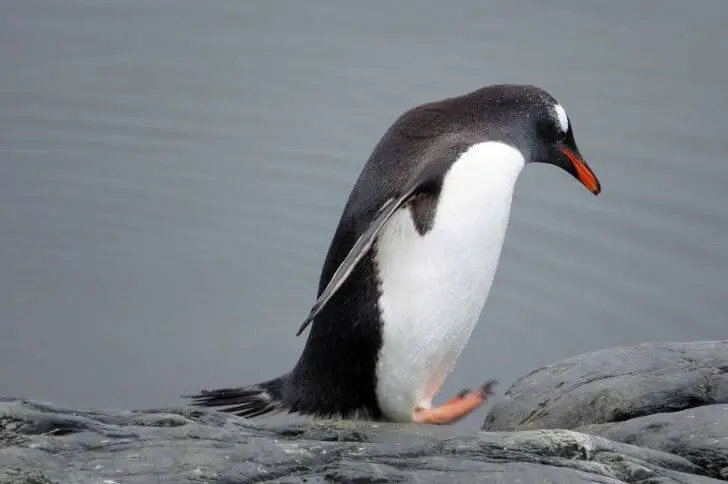
Size:
The Gentoo penguin is one of the larger penguin species, measuring around 20 to 35 inches in height and weighing around 12 pounds (5.4 kg).
Plumage:
They have a distinctive orange beak and feet, and a white chest and stomach. They also have a long tail which will help you tell them apart from other penguin species.
Habitat & facts:
What are gentoo penguins known for? They are one of the fastest swimmers, reaching speeds of up to 22 mph.
Gentoos breed from as early as June though in some places they delay until December. They breed in colonies on rocky outcrops and beaches near the water. The chicks are black with a white belly and weigh around 2 pounds (0.9 kg) at hatching.
The species is listed as vulnerable by the IUCN. There are approximately 26,000 breeding pairs left in the wild.
24. White-headed Woodpecker
Size:
Known for their sharp “pee-kik” notes, the white-headed woodpecker is a medium-sized bird that is about 8.3-9.1 inches. They can weigh anywhere from 1.9-2.3 oz.
Plumage:
They spot mostly white heads with black bodies. Note that males have a small red crown and dark eyes.
Habitat & facts:
Where can I find these birds? Their preferred habitat ranges from British Columbia to Southern California. Their meal consists of insects, which it finds by drilling into trees or logs. It builds its nest in a hole in a tree, and lays 3–5 eggs.
25. Black-necked Stilt

Size:
A mature black-necked stilt measures 13.8-15.3 inches and a wing length of 28.1 to 29.7 inches. This black bird with white belly is 5.3 to 6.2 oz.
Plumage:
Black and white; black uppers and white below. Note their red eyes and feet and a long sharp beak.
Habitat & facts:
The black necked stilt is a shorebird that can be found in North America and South America. These birds wade in bodies of water to find their meals. They eat crustaceans and small fish. They’ll also eat insects.
Black necked stilts build their nests on the ground near water. The female lays 2-5 olive speckled eggs, which both parents help to incubate. After hatching, the young chicks stay with their parents for up to 8 weeks before being able to fly and care for themselves.
26. Black honeyeater
Size:
Endemic to Australia, black honeyeaters are 3.9-5.1 in length with wings spreading around 7.5 inches.
Plumage:
These birds are sexually dimorphic. Males are longer with all-black uppers, white below, long slender curved bill and dark eyes. Females are brown streaked above and whitish below.
Habitat & facts:
Sugomel niger or the black honeyeater is a small passerine bird found in eastern and southern Australia. It is a common and familiar bird, with a range of vocalizations including a high-pitched “chwit”.
This white bellied black bird is insectivorous, foraging for insects among the leaves and branches of trees. It builds an open cup-shaped nest from grasses, bark, and other materials, which it attaches to the fork of a branch. A clutch of two or three eggs is laid.
27. Black skimmer
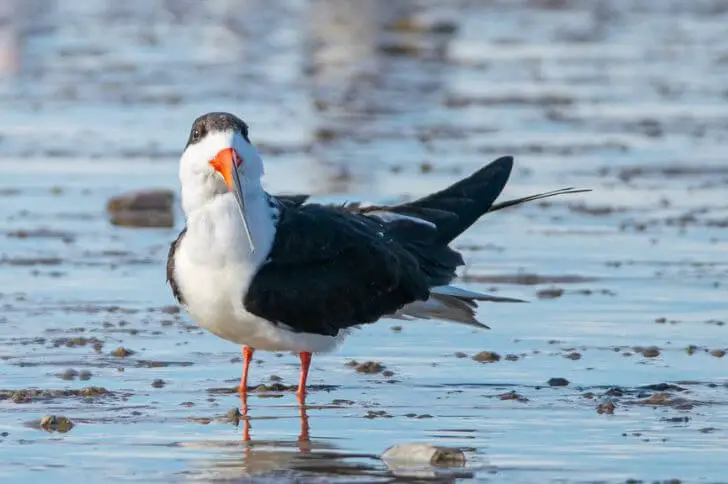
Size:
Measuring 15.8-19.7 inches in length, black skimmers are black and white birds that weigh up to 15.8 oz. They boast a 42.9-45.3 wingspan.
Plumage:
This large, long bird is easily recognizable because of its black wings and long tail, white underneath, black and red bill, and reddish-orange feet.
Habitat & facts:
This coastal bird can be found in the US, mostly California to parts of Central and South America. Black skimmers use their bills to skim the surface of the water for fish and other prey. They are very vocal birds, and can often be heard making a variety of calls. Black skimmers are migratory birds.
Final Thoughts on Black Birds with White Bellies
There are numerous black birds with white bellies and in this list we’ve looked at over 25 birds that fit this description. They include songbirds of America like the downy woodpecker to unique birds like the gentoo penguin. If you are into bird watching, be sure to include at least 10 birds from this list on your must-watch birds.
Hi, my name is Steve. My friend and I started the spanishbirdguides.com to share our passion with other like-minded people. So, if bird watching is your thing, you’ll love this blog. I’ll share what I’ve learnt about both local birds and those found in other parts of the world. Also, I’d love to hear your experiences.
